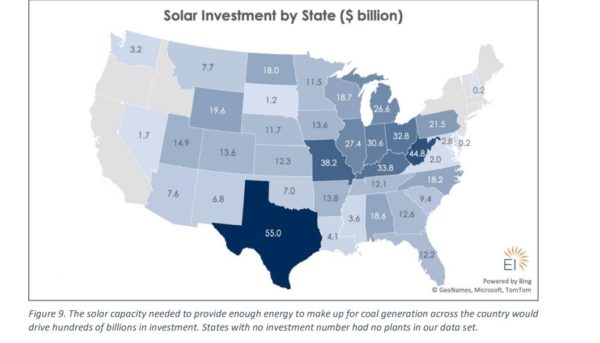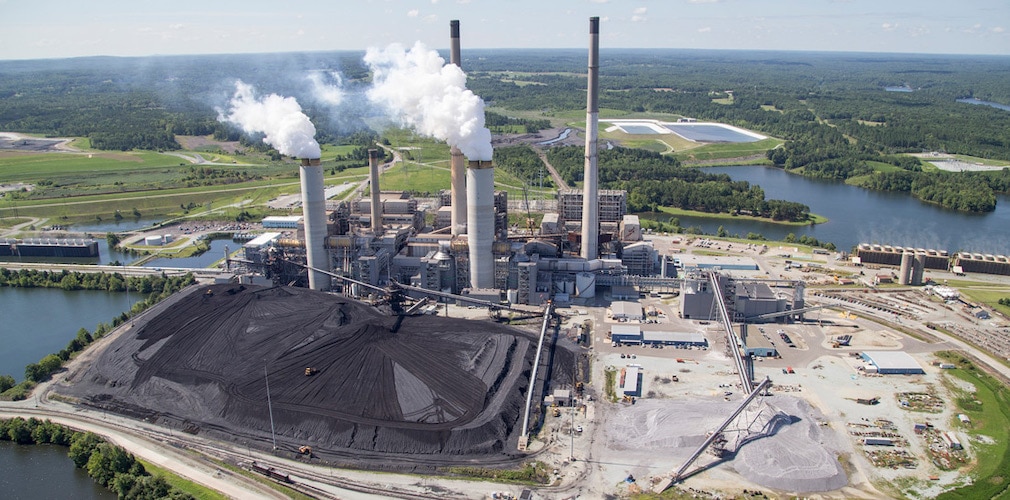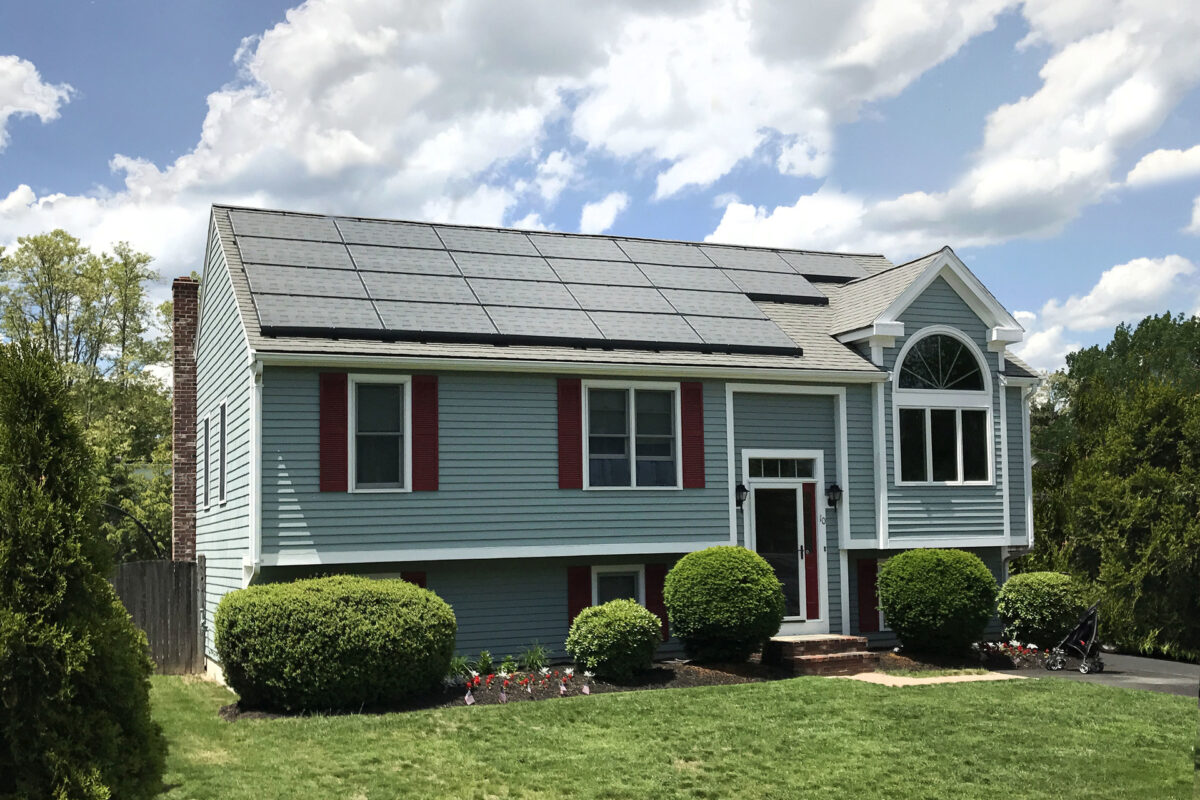The cost of operating existing coal power plants in the United States continues to increase while coal jobs, generation, and mining all decrease, according to a report released by Energy Innovation Policy & Technology, a a non-partisan energy and climate policy think tank.
Coal-fired power generation has fallen 55% from its 2007 peak to 2021, the report authors contend, and the accelerating closure of coal facilities along with the increased cost of natural gas is happening in parallel with the dropping costs of renewable energy.
In this third iteration of the Coal Cost Crossover, analysts tell a tale of an economic shift toward wind and solar, especially when considering the tax credits, loans and investment opportunities created by the Inflation Reduction Act (IRA). Noting that the IRA shines a new light on opportunities in energy communities, or areas burdened by existing coal plants, the report shows that wind and solar are “unequivocally cheaper than coal-fired generation across the country”.
The study finds that for more than three quarters of U.S. coal capacity, the cost per MWh of the cheapest renewable option is at least a third cheaper than the going-forward costs for the coal it would replace. Analysts compared the cost of operating each U.S. coal plant in 2021, totaling 220 GW of coal capacity across the country, to the estimated costs of building new solar and wind generation.
The conclusion is that all but one of the country’s 210 coal plants are more expensive to operate than either new solar or new wind. If the IRA’s new energy community tax credit is included in the equation, 199 of the 210 plants are more expensive to operate compared to local solar resources sited within 45 kilometers of the plant. Altogether, the study identified 205 coal plants have local renewable options that would be cheaper than coal-fired electricity.
The economic benefit would drive $589 billion in local capital investment, the study finds. One advantage to siting renewable plants near a retiring coal plant is that the new plant could make use of the coal plant’s interconnection, thus solving the problem of long interconnection queues.
The savings generated by switching from more expensive coal to cheaper clean energy can be used to finance other resources, such as energy storage. The study found that the savings generated by shifting to local solar could fund the addition of 137 GW of four-hour batteries across all plants, and 80% or more of the capacity at a third of existing coal plants.
The report authors point out the human health benefits in addition to the economics of swapping coal for renewables, and suggest that regulators and system operators do the following:
- Improve methods to assess reliability and resource adequacy reflecting the reliability value of renewable portfolios and valuing the reliability attributes of a high-renewables grid.
- Update interconnection study rules to leveraging existing coal plant interconnection rights to speed grid connection processes for local renewable replacement resources.
- Encourage utilities to use IRA financing programs available through the Departments of Energy and Agriculture to remove financial barriers to coal community economic transition and investment.
- Enable competitive resource procurement.
- Require reassessment of any utility investment plan, including integrated resource plans and market-based solicitations for renewable supply, completed prior to IRA as renewables costs are now out of date.
- Plan for and fund a coal community-centered economic transition, where local clean energy resources are the anchor for a more expansive economic transition.
While coal-fired power generation is decreasing, from 2007 to 2021, the report contends that utility-scale solar and wind generation have increased more than 18,000% and 1,000%, respectively, as costs declined by 90% for solar and 72% for wind. And while these numbers are staggering, it is the new federal tax credits in the IRA make the economic case for replacing coal with clean energy unequivocal, according to the report authors.
The combined impacts of energy community, labor, and domestic content bonuses reshape solar economics in coal communities. The study finds that the median cost of new solar in these communities is about $24/MWh with low variance, while the median marginal cost of coal is $36/MWh with higher variance. This cost differential provides significant headroom for additional battery storage, which can also qualify for energy community bonuses.

The analysts found that investment in local solar resources could drive $589 billion in capital investment to energy communities across the country. The map above shows the solar cpacity needed in each state to rpvode enough energy to make up for coal generation.
The report authors followed up on their local solar scenario by looking at a solar-plus-storage replacement option for each plant that includes local solar energy plus four-hour batteries to provide additional capacity value and higher market profitability in some cases. The conclusion was that the savings available from switching from coal generation to local solar generation can finance 137 GW of four-hour battery capacity at a price of $330/kWh across the coal fleet.
The analysts found that for more than a third of the coal capacity studied, in addition to energy generation replacement with local solar, 80% or more of the plant’s capacity can be replaced with four-hour batteries at a combined levelized cost that is still less than the going-forward cost of the plant. For the remaining plants, the percentage of capacity that can be economically replaced is still quite significant: savings from renewable generation could fund storage at more than 50% plant capacity at 136 plants.
This content is protected by copyright and may not be reused. If you want to cooperate with us and would like to reuse some of our content, please contact: editors@pv-magazine.com.









Bye-bye coal. And bye-bye to the politicians still ignorant enough to keep promoting it. Don’t let the door hit you in the … on your way out.
All Solar has to be paired with storage to replace the 24/7 of Coal, Oil or natural gas fired plants. For every 100-watt hour of solar, you need 1,200 watts hours of Batteries to put all the power into. The usable sun is 2 hours less than the sunrise to sunset time for tracking solar and for fixed solar is 4 hours less than the daylight on any single say. Batteries will only store 80% of their rated capacity and cannot drop below a certain point and be useful. At the equinox, when the days are as long as the nights, tracking, unshaded panels will give you one kilo watt hour for every 100 watts of solar and fixed will give you 800-watt hours. The whole system must be rated so that it does not distribute more than 40% of its rated solar power at peak times so that reserves will power the system through the night. To replace a 50-megawatt coal or oil-fired power plant you would need 150 megawatts of solar and 1,800 megawatt hours of paired batteries to carry one through the peak evening hours and the nighttime hours before one hour after sunrise the next day. Comparing just solar to a fossil fuel powered plant is like comparing a fossil fuel plant will too little coal or oil to burn. Battery storage and maintaining that storage triples the prices of real solar generation. Buying new replacement batteries every 12 years is like the cost of re-fueling the rods in a nuclear power plant.
All of that is being accounted for in the LCOE. New solar electric plants, INCLUDING battery storage are cheaper to operate than existing coal burning plants and especially cheaper than building new coal burning plants. . . . This doesn’t even begin to account for the human health damage caused by the mercury emissions spewed into the air we breathe 24/7 by burning dirty coal. . . .
“The report joins prior editions in 2019 and 2021 that, when viewed together, show how the economics of coal power are deteriorating. In 2019, the authors found that more than 70 percent of coal plants were more expensive to operate compared to the alternative of building new wind or solar. That share has now grown to 99 percent, with only the plant in Wyoming stopping it from being 100 percent.” . . . insideclimatenews.org/news/30012023/wind-solar-coal-power-plant-costs/#:~:text=In%202019%2C%20the%20authors%20found,it%20from%20being%20100%20percent.
All of that is being accounted for in the LCOE. New solar electric plants, INCLUDING battery storage are cheaper to operate than existing coal burning plants and especially cheaper than building new coal burning plants. . . . This doesn’t even begin to account for the human health damage caused by the mercury emissions spewed into the air we breathe 24/7 by burning dirty coal. . . . “The report joins prior editions in 2019 and 2021 that, when viewed together, show how the economics of coal power are deteriorating. In 2019, the authors found that more than 70 percent of coal plants were more expensive to operate compared to the alternative of building new wind or solar. That share has now grown to 99 percent, with only the plant in Wyoming stopping it from being 100 percent.” – From: ‘New Wind and Solar Are Cheaper Than the Costs to Operate All But One Coal-Fired Power Plant in the United States’
That’s all been considered and new solar is still beating old coal burning plants.